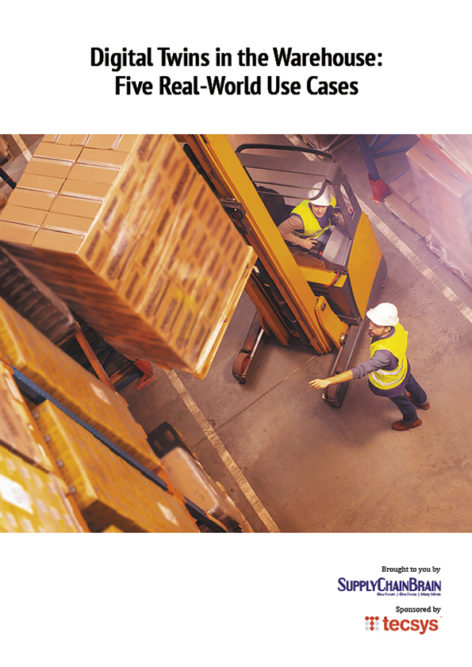
Home » Digital Twins in the Warehouse: Five Real-World Use Cases
Digital Twins in the Warehouse: Five Real-World Use Cases

March 15, 2023
Digital twins — dynamic 3D replicas of complex industrial operations — have been in use for decades in high-end production lines, power plants and laboratories. Powered by advanced data processing and analytics, they run alongside systems to monitor performance, adjust for changing conditions, predict and mitigate disruption, and test “what-if” scenarios without affecting normal operations.
Cloud-based platforms, enabled by artificial intelligence and machine learning, now deliver digital twin capability as a service for a range of use cases, among them warehousing and supply chain. Digital twins offer a 3D control tower visualization of a single warehouse, distribution network or end-to-end supply chain. With the right current and historical data collected internally and from third-party sources, twins can map warehouse activity patterns, match workflow to people and assets, anticipate disruption and model scenarios based on actual, real-time operations.
A digital twin can, for example, prioritize and allocate frontline work over a shift, optimizing fulfillment based on the available workforce given shortages and high churn rates, as well as equipment availability. It can map the warehouse to reveal areas of highest activity and redirect people and assets there, but also orchestrate work to minimize travel time and repetitive stress, as well as ensure worker safety and optimal utilization along narrow aisles and around tight corners.
As automation assumes a larger role and warehouses become more capital-intensive, twins and their underlying AI and ML technology can optimize coordination and performance while eliminating costly downtime through predictive maintenance.
Omnichannel e-commerce, meanwhile, has added fulfillment complexity, as warehouses create segregated pick, pack and replenishment spaces, manage cross-docking and returns, and incorporate last-mile micro-fulfillment centers closer to customers. Digital twins optimize time-critical workflow and space allocation, testing scenarios for promotions and tailored services as demand shifts. These capabilities extend beyond the four warehouse walls to the end-to-end supply chain, with analytics, modeling and real-time 3D visualization to build resilience in transit and in sourcing.
Please CLICK HERE to download the Top 5 Report.
RELATED CONTENT
RELATED VIDEOS
Related Directories
Subscribe to our Daily Newsletter!
Timely, incisive articles delivered directly to your inbox.
Popular Stories

2023 Supply Chain Management Resource Guide: Packing for a Difficult Year
VIEW THE LATEST ISSUECase Studies
-
JLL Finds Perfect Warehouse Location, Leading to $15M Grant for Startup
-
Robots Speed Fulfillment to Help Apparel Company Scale for Growth
-
New Revenue for Cloud-Based TMS that Embeds Orderful’s Modern EDI Platform
-
Convenience Store Client Maximizes Profit and Improves Customer Service
-
A Digitally Native Footwear Brand Finds Rapid Fulfillment



